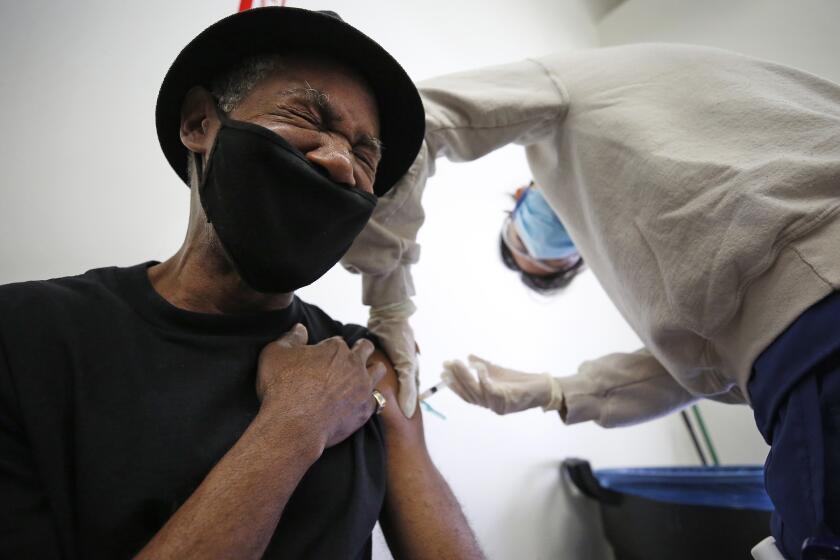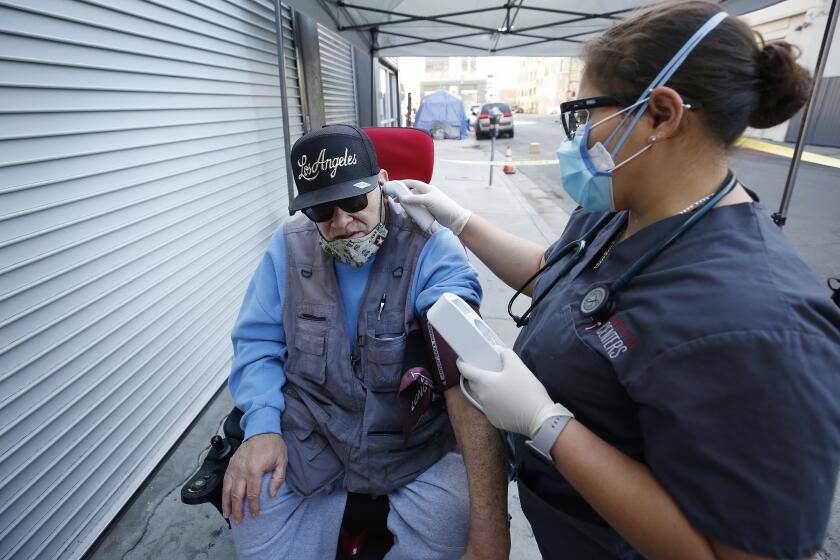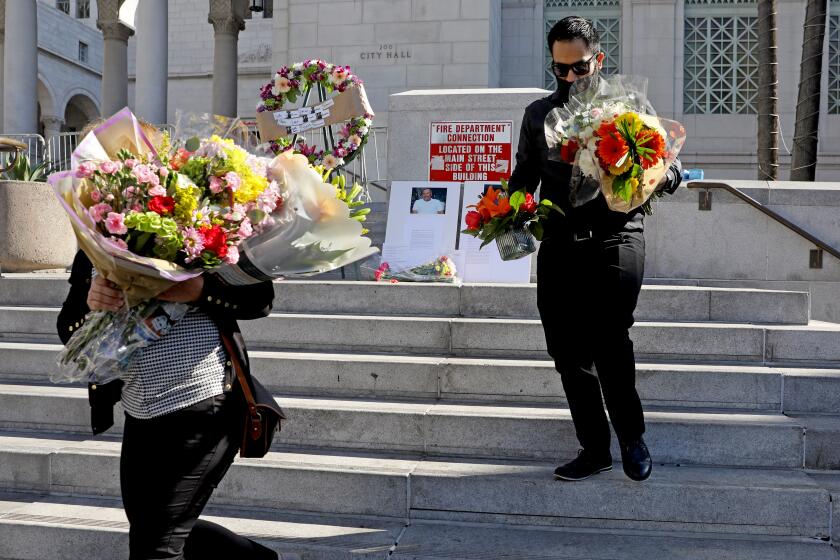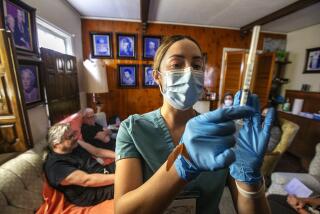The frantic race to curb racial inequities in L.A. vaccine distribution
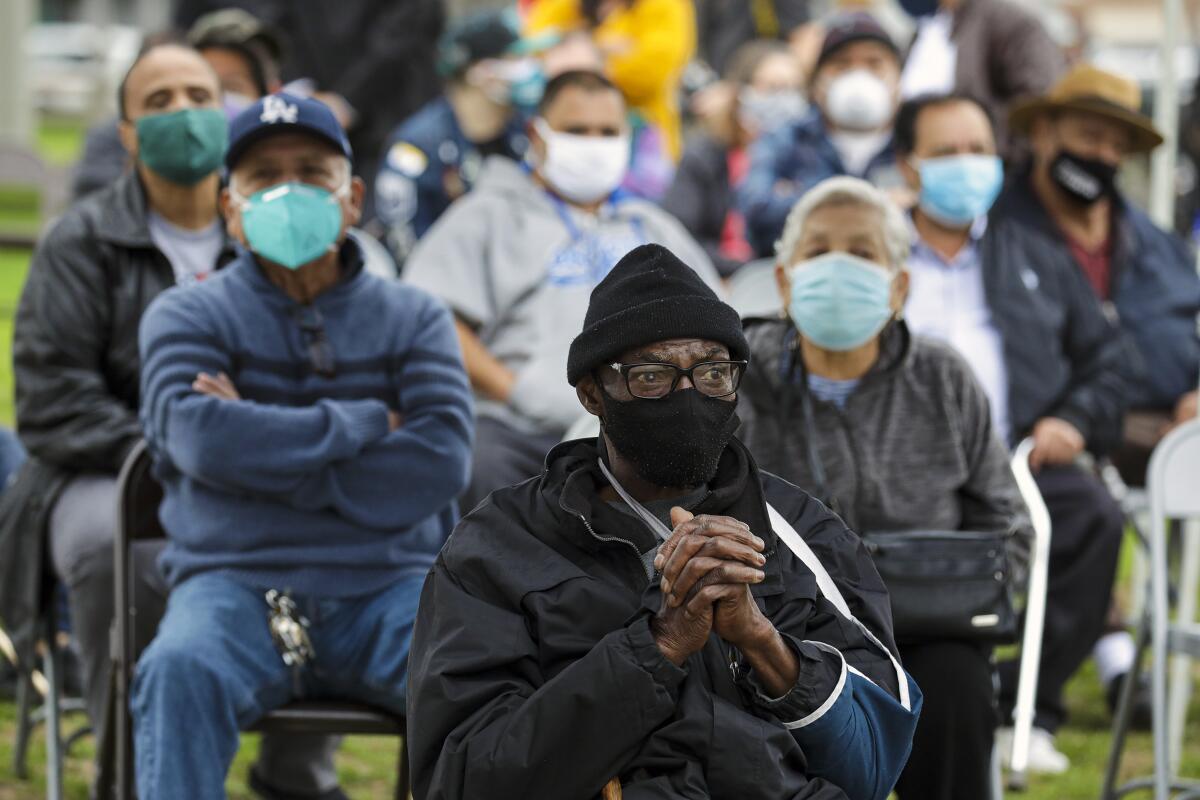
In an ideal vaccine rollout, Althea Darby would have been able to schedule a COVID-19 immunization appointment quickly and effortlessly.
The South Los Angeles resident has high blood pressure, which puts her at increased risk for serious illness if she catches the coronavirus, and she is 69, part of an age group that has been eligible for vaccination for three weeks in L.A. County.
But Darby endured an odyssey to get her COVID-19 shot.
“I had two phones going at the same time,” she said of her experience calling the county’s vaccination number last week. “I was on the line for at least six to eight hours — nothing.”
Darby couldn’t find an appointment through the county’s COVID-19 website either. Then a vaccination pod in Downey turned her away because she tried to walk up and get a shot without a reservation. On Friday, she and her husband stood in line for an hour at Hoover Recreation Center in South L.A for a vaccine, but when it was their turn, the doses had run out.
State and local officials vowed Tuesday to make improvements to ensure doses are delivered equitably and that California’s hardest-hit, harder-to-reach communities aren’t left behind.
Her struggles reflect a fundamental problem with vaccine distribution, experts say: A limited supply of vaccines has been administered unevenly. “We have virus circulating in some communities, and those are not the communities that we’re actually vaccinating,” said UCSF epidemiologist Dr. Kirsten Bibbins-Domingo.
The rate of vaccination among white and Asian seniors in L.A. County is far higher than among Black, Latino and Native American seniors, the very communities where COVID-19 case and death rates are highest, according to county data. Black residents 65 and older have the lowest vaccination rate of all the groups.
That trend is the opposite of how vaccines should be distributed if the goal is slowing transmission of the virus, both in the most devastated communities and elsewhere, Bibbins-Domingo said. Outbreaks will continue if coverage is not widespread, she added.
“What does it mean to really reach herd immunity when one part of the county might effectively have herd immunity while another part of the community really doesn’t?” she said. “Our way of interacting with one another means that people move across communities, which means that effectively we don’t have herd immunity, so the pandemic doesn’t end.”
As stark disparities emerge in vaccination rates, L.A. County officials are jump-starting efforts to improve access for people of color. Strategies include creating more vaccination sites as well as better public messaging campaigns, improving access to transportation and reserving spots at neighborhood vaccination locations before people from other parts of the county can scoop them up.
The findings raised new concerns about inequity in the troubled rollout of vaccines for those 65 and older and add pressure on county leaders to do a better job of getting communities of color immunized.
“We have a lot of work to do to fix this,” L.A. County public health director Barbara Ferrer said Tuesday at a county Board of Supervisors meeting. “However way you cut this data, it’s clear that in some of our hardest-hit communities, there are populations that are not getting vaccinated at the same rate as other groups.”
On Tuesday morning, Darby stood in line yet again, this time at a vaccination blitz in South Park aimed at administering doses to 800 seniors, particularly Blacks and Latinos, as well as healthcare workers in four days. Though there are historical and cultural issues that may make Black residents skeptical of vaccines, the biggest issue in L.A. County thus far has been access, said Councilman Curren Price, who helped plan the event.
South L.A. has very low rates of broadband internet needed to schedule online appointments and there has been much confusion about how to maneuver the county’s vaccination website, he said. Price worked with churches, nonprofit groups as well as senior and public housing facilities in South L.A. to encourage people to come get the shot, while enlisting city and private buses and vans to transport seniors to the site.
“Frequently, our residents are left out,” he said, watching masked seniors line up for the shot Tuesday. “You’ve seen the numbers. ... This is our opportunity for us to bring the shots to the community, making sure our residents take advantage of it.”
In L.A. County, where more than 1 million COVID-19 vaccines have been distributed so far, 17% of white, 18% of Asian and 29% of Native Hawaiian/Pacific Islander residents 65 and over have gotten at least one dose, compared with only 14% of Latino seniors, 9% of Native American seniors and 7% of Black seniors, according to county data.
If these trends continue, the major COVID-19 surges that threaten to overwhelm hospitals will not stop, Bibbins-Domingo said. Latinos of all ages are hospitalized at high rates with COVID-19, so they need to be vaccinated at high rates as well, she said.
“The hospital systems that serve these communities are not going to avoid the hospital overload when cases rise again,” she said.

Though vaccinations will prevent deaths, communities where large numbers of people remain unvaccinated will continue to see major outbreaks at workplaces as well as deadly surges at hospitals, she added.
Rhonda M. Smith, executive director of the California Black Health Network, said California’s slow start in public outreach about the the vaccine to the general population has been compounded in black communities by skepticism toward the medical establishment.
In California, less than 30% of Black people said they would probably or definitely get vaccinated, according to a survey published by the Public Policy Institute of California.
Most of L.A. County’s limited vaccine supply is going to giving second doses as local and state officials say they need more shots.
“Where’s the trust? And how can you convince someone that this vaccine is good for you, and you should take it for x, y and z reasons?” Smith said.
UC Riverside medical sociologist Richard Carpiano said that years of public health efforts have shown the need to use local sites that people already trust, like churches, barbershops and beauty parlors to increase participation among underserved groups.
“It’s wonderful we got Dodger Stadium but ... enough with that. I’d like to see more attention being paid to what are the other ways we’re also trying to instill vaccine access,” he said.
Marilyn Shugars, who lives in South L.A., debated whether to go to the vaccination event Tuesday. She felt as though she had heard mixed messages about the vaccines and didn’t quite understand how they were produced so quickly.
She said that if there had been a long line at the site, she would have turned around and gone home. But there wasn’t. She got her vaccination.
“If this is going to save us, then I’ll risk it for the benefit,” she said.
Supervisor Hilda Solis, who chairs the Board of Supervisors, said the county must quickly get “boots on the ground” in hard-hit communities of color, including using mobile units to offer vaccinations door to door to residents, especially to those who don’t have vehicles or are homebound.
Public service law groups want a judge to bar the L.A. County court system from holding in-person traffic or eviction trials during the pandemic.
Solis said she recently visited a county vaccination site and heard from residents who had to take multiple buses to get there. The board voted Tuesday to look into how to use transit services and rideshare companies to provide direct routes.
“It’s not only a matter of equity but in my mind, it’s also a matter of ethics,” Solis said. “It is the right thing to do.”
Supervisor Holly Mitchell, whose 2nd District includes a significant percentage of the county’s Black population, said that when residents hear of new vaccination sites opening in their communities, the natural assumption is that they will be able to get their vaccines at those sites. But that hasn’t happened at the rate it should because of the registration issues and people from other neighborhoods taking those appointments.
“That’s why our equity numbers are as paltry as they are,” Mitchell said.
Darby and her husband waited an hour for their vaccination Tuesday. She said the vaccination would bring her some relief, particularly after her own brother, who lives in Arkansas, contracted the virus.
“I know I’ll still need to keep doing what I’m doing now,” she said. “But I will feel more protected.”
Times staff writer Erin B. Logan contributed to this report.
More to Read
Sign up for Essential California
The most important California stories and recommendations in your inbox every morning.
You may occasionally receive promotional content from the Los Angeles Times.

